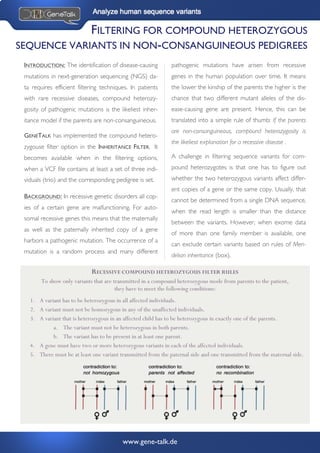
GeneTalk Compound Heterozygous Filtering Whitepaper
- 1. 2 1 FILTERING FOR COMPOUND HETEROZYGOUS SEQUENCE VARIANTS IN NON-CONSANGUINEOUS PEDIGREES INTRODUCTION: The identification of disease-causing pathogenic mutations have arisen from recessive mutations in next-generation sequencing (NGS) da- genes in the human population over time. It means ta requires efficient filtering techniques. In patients the lower the kinship of the parents the higher is the with rare recessive diseases, compound heterozy- chance that two different mutant alleles of the dis- gosity of pathogenic mutations is the likeliest inher- ease-causing gene are present. Hence, this can be itance model if the parents are non-consanguineous. translated into a simple rule of thumb: If the parents GENETALK has implemented the compound heterozygouse filter option in the INHERITANCE FILTER. It are non-consanguineous, compound heterozygosity is the likeliest explanation for a recessive disease . becomes available when in the filtering options, A challenge in filtering sequence variants for com- when a VCF file contains at least a set of three indi- pound heterozygotes is that one has to figure out viduals (trio) and the corresponding pedigree is set. whether the two heterozygous variants affect differ- BACKGROUND: In recessive genetic disorders all copies of a certain gene are malfunctioning. For autosomal recessive genes this means that the maternally as well as the paternally inherited copy of a gene harbors a pathogenic mutation. The occurrence of a mutation is a random process and many different ent copies of a gene or the same copy. Usually, that cannot be determined from a single DNA sequence, when the read length is smaller than the distance between the variants. However, when exome data of more than one family member is available, one can exclude certain variants based on rules of Mendelian inheritance (box). RECESSIVE COMPOUND HETEROZYGOUS FILTER RULES To show only variants that are transmitted in a compound heterozygous mode from parents to the patient, they have to meet the following conditions: 1. A variant has to be heterozygous in all affected individuals. 2. A variant must not be homozygous in any of the unaffected individuals. 3. A variant that is heterozygous in an affected child has to be heterozygous in exactly one of the parents. a. The variant must not be heterozygous in both parents. b. The variant has to be present in at least one parent. 4. A gene must have two or more heterozygous variants in each of the affected individuals. 5. There must be at least one variant transmitted from the paternal side and one transmitted from the maternal side. www.gene-talk.de
- 2. 4 3 EXAMPLE: Analysis of exome data from a family with and scientific evidence of the variant calls, reveals two siblings affected by Mabry syndrome (also known PIGO as the disease candidate gene and the muta- as hyperphosphatasia with mental retardation syn- tions were confirmed as the causative mutations of drome) demonstrates how effective the inheritance the disorder. filter reduced the amount of sequence variants. Starting with 27,584 variants the data was filtered CONCLUSION: The rule set, on which the filter is for genotype frequency (0.1%), and effects on pro- based, is comprehensive for analyzing multiple sam- tein level leaving over only 1446 variants. The com- ples and advances the prioritization of compound pound heterozygous filter reduces this set to just six heterozygous variants. It shows that filtering for variants in three distinct genes, NBPF10, MUC4, and compound heterozygous mutations is an effective PIGO. A quick assessment of the medical relevance means in identifying disease candidate genes especially when several family members are available for the analysis. In a trio analysis e.g. with exome data of the parents and one affected child, only about a dozen of variants in candidate genes remain after applying the filter. This manageable number of remaining genes can then be assessed based on the expertise of the investigator or further prioritized by suitable tools at www.Gene-Talk.de. REFERENCE: Krawitz PM, Murakami Y, Hecht J, Kruger U, Holder SE et al., Mutations in PIGO, a member of the GPI-anchor-synthesis pathway, cause hyperphosphatasia with mental retardation. Am J Hum Genet, 2012, 91: 146-151. Kamphans T, Sabri P, Zhu N, Heinrich V, Mundlos S, et al., Filtering for Compound Heterozygous Sequence Variants in NonConsanguineous Pedigrees. PLoS ONE, 2013, 8(8): e70151. www.gene-talk.de